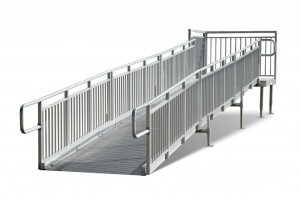The Americans with Disabilities Act (ADA) determines ADA ramp slope requirements. These requirements continued evolving several decades after the law was passed.
 At REDD Team, we understand the mandates for making commercial, industrial, military, and municipal facilities safe and accessible for people in wheelchairs and other forms of accessibility devices. Therefore, we ensure that the access systems we supply to our clients are ADA compliant. Your facility requires an ADA compliant ramp to make it more accessible and avoid hefty penalties that come with non-compliance. It is essential to consider ramp location, size, and slope.
At REDD Team, we understand the mandates for making commercial, industrial, military, and municipal facilities safe and accessible for people in wheelchairs and other forms of accessibility devices. Therefore, we ensure that the access systems we supply to our clients are ADA compliant. Your facility requires an ADA compliant ramp to make it more accessible and avoid hefty penalties that come with non-compliance. It is essential to consider ramp location, size, and slope.
Importance of ADA Ramps
ADA ramp requirements are designed to minimize accidents, such as slips, falls, and trips in private and public facilities. In addition, they enhance accessibility for people with mobility problems. For people with mobility problems, obstructions can limit their movements and even make it dangerous for them to access specific locations.
REDD Team has excellent knowledge and understanding of ADA requirements for ramp slopes. We can help answer some of your questions about ramp slope requirements for commercial and industrial buildings, municipal facilities, and military installations.
Ramp Location
The ADA requires building owners and managers to install ramps in specific locations to enhance movement and accessibility for people with mobility limitations. Ramps should be installed along accessible routes in commercial and industrial facilities, especially if the path has a height change greater than six inches.
All areas with a slope greater than five percent must have ADA-compliant ramps. REDD Team ramps comply with specific design standards, including:
- Ramps must have clear widths of at least 3 feet between their handrails
- Although ADA does no limit on the number of ramp runs, each run must not exceed 2.5 feet
- Ramp slope must not exceed a ratio of 1:12, meaning each foot of elevation must correspond to 12 feet
- The cross slope must not exceed a ratio of 1:48
Ramps must comply with specific width requirements. In any case, the standard width of a ramp does not include indentations, flared sides, and other design features. ADA requirements do not place restrictions on ramp length, provided it does not exceed a height of 2.5 feet. REDD Team can configure longer ramps into a series of smaller interconnected ramps to enhance mobility.
Ramp Slope
Slope refers to the ratio of a ramp’s height to its length. The slope of ADA compliant ramps must not exceed 8.33 percent. In addition, ramp slopes are required to be consistent from end to end, meaning the slope must be uniform with a few exceptions depending on building material.
Landings
Ramps must have landings at the top and bottom with a level that should not exceed a ratio of 1:48. In addition, intermediate landings between runs must have a clear width of at least five feet. The ramp path should not have any obstructions, such as edge protectors, vertical posts, or handrails.
REDD Team designs and manufactures quality ramps for clients in our Delhi, LA facility. Our ramps are ADA and OSHA compliant. The top and bottom of our ramp runs have one-foot-long handrail extensions. In addition, the extensions are in a continuous direction with the ramp. The ramp design, including the landings and transitions, also prevents water pooling.
For additional details about ADA ramp slope requirements, please contact REDD Team today.
